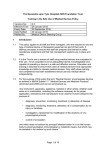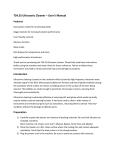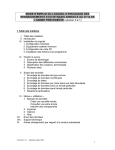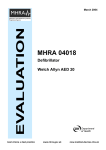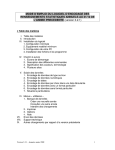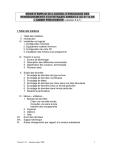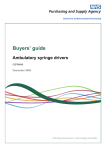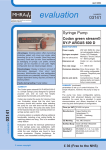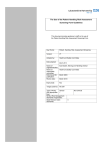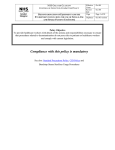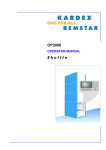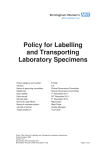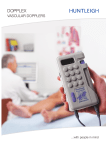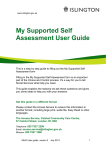Download Sheffield Care Trust - Sheffield Health and Social Care
Transcript
Sheffield Care Trust Mental Health and Wellbeing Policy Title/Subject: Medical Devices Management Policy Issued By: Date of Issue: Risk Management Department Nursing Policy & Practice Development Group November 2006 (Original August 2005) Date of review: July 2008 Contents Sheffield Care Trust contacts Background Purpose of the Policy Definition of a Medical Device Responsibilities Procurement of Medical Devices Modification and Adjustments Commissioning and Use Instructions for end users provided by the Trust Single use items Maintenance and Repair Decontamination Disposal of Medical Devices Alerts and Guidance Sheffield Community Equipment Loan Service (SCELS) Bibliography Appendix 1 - Medical Devices Agency Common Categories of Medical Device Appendix 2 - Sheffield Community Medical Devices Group Appendix 3 - Procedure for the receipt of a new medical device Appendix 4 - Delivery checklist Appendix 5 - Procurement of Medical Equipment/Devices Description This policy outlines the roles and responsibilities of staff in relation to procurement, acceptance, use, decontamination, maintenance, training, disposal of medical devices and reporting adverse incidents. Related policies: Work Equipment Policy – details equipment inventory including maintenance and training Infection Control guidelines Safety Alert Broadcasting System (SABS) Policy Incident Reporting and Investigation Policy Sheffield Care Trust Contacts Reference in this Policy Named person in SCT Telephone Medical Devices Liaison Officer Clinical Risk Manager 27 16371 Safety Alert Broadcast System Officer Health & Safety/Risk Adviser 27 16752 Procurement/Purchasing Supplies Department 27 16176 Infection Control Infection Control Nurse 27 16720 Decontamination Infection Control Nurse 27 16720 Sheffield Community Equipment Loan Service (SCELS) 22 63800 Disposal of Medical Devices Estates Department 27 18183 Sheffield Community Medical Devices Group Clinical Risk Manager 27 16371 Supplies Department Representative 27 16155 Infection Control Nurse 27 16720 2 1.0 Background This policy was initially produced by the Sheffield Community Citywide Medical Devices Group in March 2005. This review has been carried out by and for Sheffield Care Trust. 1.1 Some of the health care provided by Sheffield Care Trust involves the use of one or more medical devices. Safe and effective management of medical devices is a vital component of the Safety Domain of the Standards for Better Health: “patient safety is enhanced by the use of health care processes, working practices and systematic activities that prevent or reduce the risk of harm to patients.” (National Standards, Local Action. DoH 2004) 1.2 This policy covers the roles and responsibilities of staff in relation to procurement, acceptance, use, decontamination, maintenance, training, disposal of medical devices and reporting adverse incidents. The aim of the policy is to ensure that whenever a medical device is used, it should be: - 1.3 Suitable for its intended purpose Properly understood by the user Maintained in a safe and reliable condition This policy applies to all directly managed staff within Sheffield Care Trust and should be used as good practice for independent contractors. 2.0 Purpose of the Policy 2.1 The purpose of the policy is to ensure that: • • • • Patient and staff safety is enhanced by the use of processes, working practices and systemic activities that prevent or reduce the risk of harm to patients. All risks associated with the acquisition and use of medical devices are minimised. All reusable medical devices are properly decontaminated prior to use and that associated risk with decontaminated facilities and processes are well managed. The Trust fulfils the requirements of the NHS Standards for Better Health. (National Standards, Local Action. DoH 2004) and the NHSLA standards for Risk Management (NHSLA 2006, Clinical Negligence Scheme for Trusts). 3.0 Definition of Medical Device 3.1 A medical device can be defined as any instrument, apparatus, appliance, material or healthcare product, excluding drugs, used for a patient for the purpose of: • • • • Diagnosis, prevention, monitoring, treatment or alleviation of a disease, injury or disability Investigation, replacement or modification of the anatomy or of a physiological process Control of conception This does not include general workshop equipment such as power or machine tools, or general-purpose laboratory equipment (see Appendix 1). 3 4.0 Responsibilities 4.1 The Chief Executive will nominate an Executive Director who will be accountable for Medical Devices management who will:• • • 4.2 Assume accountability for medical devices management within the Trust. Review allocation of resources to meet identified needs in relation to medical devices management. Ensure compliance with the requirements of the Standards for Better Health and Clinical Negligence Scheme for Trusts standards in relation to Medical Devices. Department/Team Managers responsibilities: • • • • • • • • Ensure that the staff working within their area of responsibility adhere to this policy. Establish local procedures to ensure that working arrangements meet the requirements for the procurement, use, decontamination, maintenance and end of life of the equipment of medical devices provided by the manufacturer. Ensure that staff undergo training and are competent to use the medical devices within their area of responsibility. Monitor training relating to the management of medical devices Action any hazard and safety notices (refer to SABS Policy) and comply with any guidance on changes to the use of a device. Ensure that single use medical devices are not reused. Ensure a live inventory of all medical devices is kept for their service/department (as in Work Equipment Policy). Ensure clinicians are consulted with respect to the procurement of medical devices. 4.3 All staff responsibilities 4.31 All staff should ensure that they have received the appropriate training before using devices. 4.32 Individuals have a responsibility to report any defects or adverse incidents resulting from the use of medical device in accordance with their own trust policy. 4.4 Independent contractors. 4.4.1 All independent contractors are wholly responsible for the management of risks within their practice. To support Independent Contractors in satisfying this duty the Trust recommends full compliance with this policy. The provision of directly managed Trust services within an Independent Contractor’s practice may be dependent on full compliance with all the Trust’s governance policies and procedures. Failure to provide evidence of compliance may result in the withdrawal of direct Trust services. 4.5 Sheffield Medical Devices Group 4.5.1 The Sheffield Community Medical Devices Group consists of representatives from the Sheffield PCTs and Sheffield Care Trust. The purpose of the group is to improve communication between these organisations and to take a collective approach to the control of risks in respect of the management of medical devices. 4 4.5.2 The Sheffield Medical Devices Group has lines of accountability to each of the Trusts that it serves (for Terms of Reference see Appendix 2). 4.6 Local medical devices arrangements. 4.6.1 The Trust should ensure that there is a forum to discuss all issues relating to medical devices at a local level. The Nursing Policy and Practice Development Group is the current forum to discuss issues relating to medical devices. 5.0 Procurement of Medical Devices 5.1 Managers will adhere to Standing Financial Instructions in the procurement of medical devices. 5.2 Trust may wish to consider seeking advice prior to the procurement of medical devices from the Trust procurement advisor and other appropriate people including the Medical Devices Liaison Officer (see appendix 5). 5.3 On receipt of a new medical device, Department/Team Managers will follow the procedure outlined in Appendix 3. 6.0 Modification and Adjustments 6.1 Modification or adjustment is only be made by the manufacturer or by someone qualified to do so. 6.2 Medical devices are only used for the purpose for which they were designed. 7.0 Commissioning and Use 7.1 Medical devices are not used until the full functionality and safety have been validated. Only a person who is competent to fully understand the correct operation of the device and to identify any malfunction or faults in operation will undertake tests and checks. 7.2 The test and results of such tests will be recorded in the history log for the device by a nominated person. All tests and checks must conform to the guidance in Medical Devices Agency, Device Bulletin DA DB9801 (Medical Device and Equipment Management for Hospital and Community-based Organisations). www.mhra.gov.uk/ 7.3 All staff using medical devices have an individual responsibility to be competent to do so and managers should ensure training is undertaken before equipment use. Staff lacking competence to use medical devices necessary for their work must inform their line manager so that the training need can be addressed. 7.4 Managers will use the induction and appraisal process to identify training needs in relation to medical devices. 5 7.5 Up-to-date operating instructions and user manuals will be available at all times for any person using the device, and must be followed in relation to use, decontamination, handling, storage and reporting faults. 7.6 All incidents involving medical devices will be reported to the Medicines and Healthcare products Regulatory Agency (MHRA) by Risk Management Department, on receipt of an Incident Form (using Trust Incident Reporting and Investigation policy) 7.7 A defective device will be removed from use, quarantined and must not be tampered with in any way. It will only be handled by an authorised person until the investigation is complete. 7.8 If medical devices are loaned or supplied to patients, carers or other health care staff it is the responsibility of the refer/ provider to be assured that the mechanisms are in place to ensure that the end user has appropriate instructions and where appropriate has training and a level of competence in its use and decontaminated before its use. 8.0 Instructions for end users provided by the Trust 8.1 If the instructions for use provided by the manufacturer do not meet the needs of the end user, (for example, because of disability or special visual needs), the Trust will provide instructions in an alternative format. Sheffield Community Equipment Loan Service can assist. 8.2 Instructions provided by the Trust will be submitted to the manufacturer for their approval before use. 9.0 Single use items 9.1 Devices designated for ‘single use’ must not be reused under any circumstances. The designated symbol for ‘single use’ is: 2 10.0 Maintenance and Repair 10.1 Managers will ensure that all devices are maintained accordance with the manufacturer’s instructions and relevant legal requirements. (For further advice see; MDA DB 2000(02)). In-house repairs and maintenance will only be undertaken by staff who are fully trained and competent to do so. Managers will maintain systems to ensure that all aspects of repair and maintenance are documented accurately, detailed and accessible. 10.2 10.3 6 11.0 Decontamination 11.1 Decontamination of reusable medical devices will be addressed in line with the Sheffield District Infection Control Guidelines (May 2003) or trust policy. Advice is available from the Trust Infection Control Nurse. 12.0 Disposal of Medical Devices 12.1 Medical devices no longer required will be disposed of in a safe manner, in compliance with MDA DB9801and the WEE Directive (WEE Directive 2002/96/EC). 12.2 Disposal of redundant medical devices will be by, transfer of ownership, decommissioning or disposal in line with the Trust policy for waste disposal. 12.3 In cases of transfer of ownership - decontamination certificates, maintenance records and operating instructions, will be transferred with the device at the time of transfer. 12.4 When devices are decommissioned - decontamination certificates, maintenance records and operating instructions will be retained within departments. 13.0 Alerts and Guidance Safety Alert Broadcast System/ Medical Devices Liaison Officer 13.1 The Trust will have a nominated person who will ensure that there is a system within the organisation to communicate MHRA alerts to relevant staff and receive information on action taken as a result of the alert. Refer to the Trust SABS Reporting Policy. 13.2 All staff should report all medical devices incidents using the Trust Incident Reporting and Investigation policy and the Medical Devices Liaison officer is responsible for reporting to the MHRA (MHRA 2005). 14.0 Sheffield Community Equipment Loan Service (SCELS). 14.1 The Sheffield Community Equipment Loan Service (SCELS) is an integrated service between Health and Social Care with Sheffield Care Trust as the service provider. SCELS has responsibility for a number of activities associated with the loan of equipment to patients/clients in the community including: - 14.2 Purchase Storage Issue and Retrieval Referrer and service user information Re-cycling (including decontamination) Repairs, servicing and maintenance Cleaning and decontamination SCELS will ensure that all relevant legislation and guidance is implemented and that systems and procedures to support effective and efficient service delivery are implemented and maintained. 7 15.0 Bibliography HSG(93)26-Health Service Guidelines-Decontamination of equipment prior to inspection, service or repair Medical Device and Equipment Management for Hospital and Community-based Organisations. www.mhra.gov.uk/ MDA DB2000 (02)- Medical Device Agency Device Bulletin2000(02)- medical device and equipment: repair and maintenance provision. www.mhra.gov.uk/ Medical Devices Agency (2002) Devices in Practice, DOH London. www.mhra.gov.uk/ MDA DB2000(04)- Medical Device Agency Device Bulletin2000(04)-single-use Medical Devices: implications and consequences of reuse. www.mhra.gov.uk/ MDA DB2000(04)- Supplement 2. Guidance on the sale, transfer of, ownership and disposal of used medical devices. www.mhra.gov.uk/ MDA DB 9801- Medical Device Agency Device Bulletin 9801-Medical Device and equipment management for hospital and community-based organisations. www.mhra.gov.uk/ Medical Devices Agency (2002) Devices in Practice, DOH London. www.mhra.gov.uk/ Medicines and Healthcare Regulatory Agency Annual Report 2004. www.mhra.gov.uk/ Medicines and Healthcare products Regulatory Agency 2005 (MHRA DB2005(01). Reporting Adverse Incidents and Disseminating Medical devices Alerts. National Standards, Local Action. DoH 2004 NHSLA Risk Management Standards (2006) Sheffield District Infection Control of Infection Guidelines (2003) available via Sheffield Care Trust Infection Control web pages Waste Electrical and Electronic Equipment (WEEE) Directive (2002/96/EC) 8 Appendix 1 Medicines and Healthcare products Regulatory Agency (MHRA) Common Categories of Medical Device (this list is not exhaustive. It provides examples of medical devices) Equipment in the diagnosis or treatment of disease, or monitoring of patients, such as: • Chiropody and podiatry equipment • • • • • • Dressings Examination gloves Intravenous (IV) administration sets and pumps • Nebulisers • Ophthalmic equipment • Peak flow meters • Surgical instruments • Suction equipment • Syringes and needles • Sphygmomanometers • Thermometers • Ultrasound dopplers • Urinary catheters Equipment used in life support, such as: • • • • • Defibrillators Insulin Injectors Domiciliary oxygen therapy systems Ventilators used in home Pulse oximeters In vitro diagnostic medical devices and their accessories, such as: • Blood glucose measuring devices • Cholesterol test kits • Pregnancy test kits • Specimen collection tubes • Urine test strips Equipment used in care, such as: • Adjustable beds • Lifting poles • Patient hoists • Pressure relief equipment • Stoma care equipment Equipment used by people with disabilities, such as: • Bathing equipment • Commodes • External prostheses and orthoses • • • • • • • Hearing aids Incontinence aids Prescribable Footwear Standing frames Urine drainage systems Walking aids Wheelchairs and special support seating Other examples include: • Condoms • Contact lenses and care products • Intra-uterine devices (IUDs) Medical Devices Agency (2002) Devices in Practice, DOH London 9 Appendix 2 Sheffield Community Medical Devices Group Purpose • To improve communication across the Sheffield Primary Care Trusts and Sheffield Care Trust with respect to medical devices management. • A collective approach across the member organisations with respect to the management of risks associated with the use of medical devices. Accountability • Via the committee structures of the individual member organisations to their Trust board. Functions • To produce and maintain a Sheffield Primary Care and Care Trust wide policy on the total management of medical devices. • To develop an information network for the procurement and clinical use of medical devices. • To share information on best practice about equipment management, maintenance procedures and decontamination of medical devices. • To share information about adverse incidents related to medical devices management and to consider the learning from theses incidents. • To share training opportunities for the relevant staff in relation to medical devices. • To develop a Sheffield wide plan to implement a common approach to national standards. • To develop communication with independent contractors and local committees. Composition of the Medical Devices Group • The Committee is multi-disciplinary, which includes senior professionals from key agencies across Sheffield Membership • Primary Care Trusts Medical Devices Liaison Officer/SABS officer • Sheffield Care Trust Medical Devices Liaison officer/SABS officer • Infection Control Nurse • Supplies / purchasing representative • Health protection Agency Frequency of meetings • Quarterly • On alternate sites Minutes • For distribution to the appropriate committees within each member organisation • To receive the minutes from the District Infection Control Committee and to send copies form this group. 10 Appendix 3 Procedure for the receipt of a new medical device Managers will adhere to the following procedure when taking receipt of new medical devices:i) Check that the correct product, complete with operating manuals and maintenance instructions has been supplied. ii) Complete and retain the delivery checklist. (Appendix 4) iii) Ensure that product items have been delivered in good condition and in working order. iv) Ensure that a risk assessment relating to the medical device is completed and the risks are managed at reasonable levels. v) Record the details of the device (product no., serial no., etc.). vi) Comply with safety legislation vii) A written decontamination procedure is made available and stored with the records for each piece of equipment. viii) Determine the correct training requirements for the use and maintenance of each piece of equipment and retain evidence of all training. ix) Initiate a history for any items requiring service. x) Ensure that devices are fully functional in line with manufactures’, NHS and statutory requirements. 11 Appendix 4 Delivery checklist A Equipment Details 1. Decontamination certificate Yes/No 2. Date 3. Supplier 4. Device type 5. Delivery note checks with order? Yes/No 6. Goods checks with delivery note? Yes/No 7. Model/type identification 8. Serial Number 9. Mains voltage 10. Leads supplied Yes/No 11. Accessories supplied Yes/No 12. User manual supplied Yes/No 13. Instructions supplied Yes/No 14. Maintenance manual supplied Yes/No 15. Warranty document included Yes/No 16. Final test certificate supplied Yes/No 17. Local serial/inventory number 18. Device type new to healthcare facility Yes/No 19. - If yes, instructions circulated appropriately 20. “New Device” sticker attached Yes/No Yes/No B Visual Inspection 1. Outer packaging undamaged? Yes/No 2. Case not dented/broken Yes/No 3. Panels etc. secure Yes/No 4. No rattles Yes/No C Electrical safety 1. Moulded IEC mains connector and mains plug 12 - Connectors firmly attached Yes/No - No cores or bare wires visible Yes/No - Outer insulation intact Yes/No - Appropriate fuse fitted (see manual) Yes/No - Fuse holder secure Yes/No 2. Mains lead permanently attached - Cord grips satisfactory Yes/No - Fuse value - Plugs and sockets mate Yes/No - Clamps and doors latch Yes/No - Passes PAT test Yes/No D Functional check Plug in, turn on (following instruction manual) 1. Indicator lamps light up Yes/No 2. Display as described in manual Yes/No 3. Passes self test routine Yes/No 4. Moving parts operate properly Yes/No 5. Knobs and switches act properly Yes/No 13 Appendix 5 Procurement of Medical Equipment/Devices Identify Need for Equipment/Device Discuss with Trust Medical Devices Liaison Officer and through Trust forum for Medical Devices Is the Value above Trust Tender Threshold? Yes No User forwards Equipment Specification to Relevant ‘Supplies Lead Person’ for Action Tenders issued to at least 3 suppliers as per Trusts SFI’s with Electro Medical Questionnaire (EMQ) form for completion by Supplier if required Complete a Non –Stock Requisition Tenders Received and summarised by Supplies Dept. User Consulted on choice of preferred Supplier based on EMQ approval, price etc Send Non-Stock Requisition to Supplies Dept Supplies Dept Issues Official Order to Preferred Supplier Send Non–Stock Requisition to Supplies Dept Completed EMQ form passed to STH EBME Dept for Evaluation/Approval Yes User Advised of Approval Supplies Dept Issues Official Order to Preferred Supplier with EMQ Form if required No Seek further Clarification as required from Supplier On receipt of Equipment/Device suppliers delivery note to be signed and returned to Supplies Dept. Procedure on Receipt, Commissioning and Use in Med. Devices Policy to be followed. 14


















